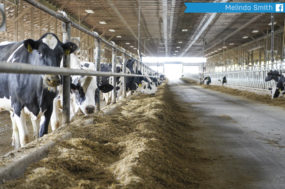A while back, I was scrolling through Facebook. And I came across a video by a large animal activist group. The video was horrible! They used videos, pictures, lies, sad music and anything else they could to play on people’s emotions to convince them of their negative agenda. As I continued scrolling, I saw it again. By then, I was wondering why this was even on my news feed. That’s when I realized it was being shared by dairy farmers! Their captions would read, “Can you believe this stuff?” or “OMG, did you see this?”
Since then I have seen this over and over again – fellow dairy farmers sharing, liking and commenting on activists’ posts online. Posts that are absolutely false, misleading and sensationalized. The only goal of most of these activists’ posts is to get a reaction from people. The problem is these posts tend to get the biggest reaction from farmers. Most of the negative, misleading posts about animal agriculture I see online are because a farmer has shared, tagged or liked a post. Every time I have to shake my head a little and wonder why a farmer decided to share such a negative post.
I do understand that when you see these outrageous posts, you want to explain how it’s not true. And some are so ridiculous that they are almost funny. I think we all saw the “Cow Crusher” hoof trimming chute post. But the problem is we are only giving activists more attention by sharing these posts. Below are the five reasons why you should not engage with these posts.
1. By engaging, you are bringing more attention to the post.
Have you ever heard the saying, “All publicity is good publicity”? Well, it’s kind of true, especially when it comes to sensationalized activist posts. They don’t care who sees their posts as long someone sees it and someone reacts to it. And the problem is that every time someone shares or likes or comments on a post, it boosts the engagement. Facebook does not know if a share or comment is because someone likes something or hates it. The Facebook algorithm only knows that a post is receiving a lot of impressions. Then it can decide to show it to even more people. Also, at the end of the day, the activist group only cares about the numbers their post recieved. By you watching it and your friends seeing it on your timeline, you are giving them more views. Good or bad, it still means people are watching it.
2. When farmers engage, it gives the post credibility.
If I see a post online that I am not sure about or that I have questions about, one of the first things I do is find out who wrote it and who shared it. Does it come from a credible website, and is the person sharing it an expert in that field? If yes, then I might take a second look at it. So when a farmer shares an activist post, it gives the post some credibility. Consumers end up seeing a video created by an animal activist group they recognize, and then they see farmers engaging with the post. Even if the farmer is voicing outrage over the post, consumers are led to believe the post has some truth to it and that is why the farmers are upset.
3. Every person on your friend list can see your interactions.
Even when you only like a post, your friends will be notified in their news feed that “so-and-so liked this post.” And if you are tagged in the comments, Facebook will share that with your friends too. Facebook is assuming that your friends might also be interested in the post. This is a problem, especially if you have a lot of friends outside of agriculture. All they see is your name associated with this negative agriculture post.
4. If you need to show a post to someone, screenshot it.
Many times, people want to share a post to discuss it with someone or use it as an example. Instead of sharing, just take a screenshot. This screenshot limits the engagements the post will have. Then you can send it in a direct message or email to a person. By doing this, you can avoid exposing everyone on your friend list to the negative content as mentioned above.
5. Know what to share instead.
I know how frustrating it can be to see these ridiculous posts online. All I want to do is respond to every single comment and tell people the truth about dairy farming. But instead, I will see if any of my fellow dairy bloggers have written a post about the topic that gives a great explanation and I will share that. If I don’t see anything out there that fits, I will write a post or record a video myself. By doing this, we can share with people fact-based blog posts. And we can also show consumers where to go online to find real dairy farmers posting about what an actual dairy farm is like. This also puts us in control of the conversation. We all know that nothing good comes out of responding in the comment section to a negative post. But some really positive conversations have been started when I share something directly about my farm or another dairy blogger’s farm.
Social media is a great way for us to reach our consumers and tell our story about dairy farmers. But it is also a great way for activists to reach consumers. Let’s not help them spread their agenda by engaging with them. Instead, be conscientious about what you are sharing and how it promotes dairy for the good. ![]()
Follow Tara at her blog, New Mexico Milkmaid.

-
Tara Vander Dussen
- Environmental Scientist - Glorieta Geoscience
- Dairy Producer - Clovis, New Mexico
- Email Tara Vander Dussen




